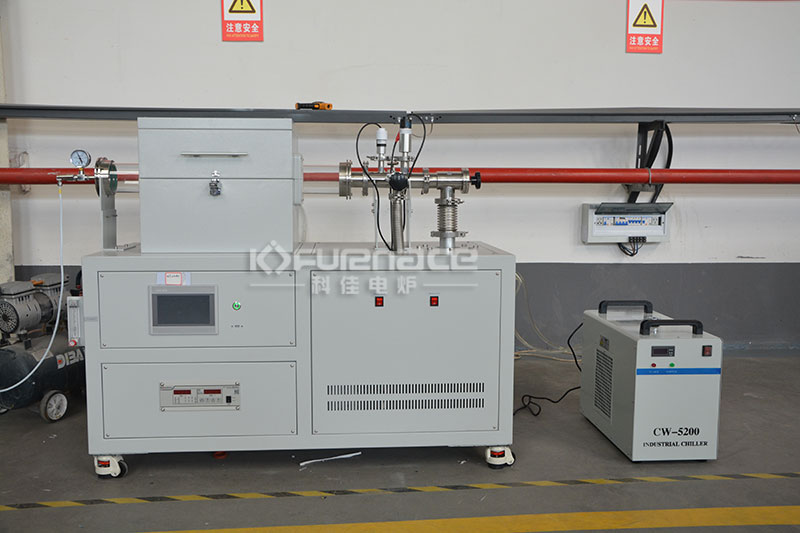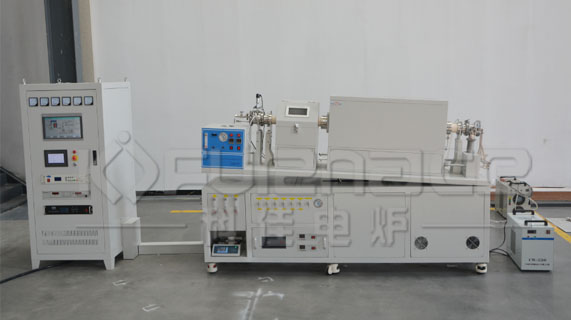The vacuum coating CVD (chemical vapor deposition) electric furnace combines vacuum environment and chemical vapor deposition technology, which has many advantages in the field of material preparation, especially suitable for the preparation of high-precision and high-performance thin films or coatings. Let’s take a detailed look below!

A customized vacuum tube CVD electric furnace (click on the image to view product details)
1. Core advantages
a. Preparation of high-purity thin films
Vacuum environment pollution suppression: Under vacuum conditions of 10 ⁻²~10 ⁻⁴ Pa, impurities such as oxygen and water vapor in the air can be effectively eliminated, avoiding film oxidation or pollution. It is suitable for preparing high-purity metal, semiconductor or ceramic films (such as high-purity aluminum film, silicon film).
Reduce gas molecule interference: Low pressure environment reduces the collision frequency of gas molecules, allowing the reaction gas to deposit more accurately on the substrate surface and improving the uniformity of the film.
b. Accurate control of film composition and structure
Dynamic adjustment of gas flow rate: By using a mass flow meter (MFC) to accurately control the proportion of reaction gases (such as SiH ₄, NH3), gradient design or doping control of film composition can be achieved (such as precise control of nitrogen content in silicon nitride films).
Temperature gradient control: Electric furnace zone temperature control technology (such as independent heating zone) can create temperature gradients, guide the direction of film growth, and prepare special structures such as columnar crystals and nanowires.
c. Excellent film adhesion
Substrate pretreatment function: The electric furnace can integrate plasma cleaning or ion bombardment modules to activate the substrate surface (such as removing oxide layers), enhance the chemical bonding between the film and the substrate, and improve adhesion.
In situ annealing treatment: After deposition, annealing is directly carried out in a vacuum environment to eliminate internal stress in the film and reduce the risk of cracking (such as annealing treatment of diamond films).
d. Wide adaptability of materials
Support multiple deposition techniques: compatible with PECVD (plasma enhanced CVD), LPCVD (low-pressure CVD) and other variant technologies, capable of preparing thin films of refractory materials such as silicon carbide and gallium nitride.
Flexible substrate shape: suitable for flat, curved, or complex structural substrates (such as fiber optic coatings, aircraft engine blade coatings).
e. Process stability and repeatability
Closed loop control system: integrating pressure, temperature, and gas flow multi parameter feedback regulation to ensure small fluctuations in process parameters, suitable for large-scale industrial production.
Data traceability function: Record key parameters during the sedimentation process (such as temperature rise curve, gas flow rate changes) for quality control and process optimization.
2. Typical application scenarios
a. Semiconductor industry
Crystalline silicon solar cells: Deposition of silicon nitride (SiN ₓ) anti reflection film to improve cell conversion efficiency.
Integrated circuit manufacturing: Prepare high-k gate dielectric layers (such as HfO ₂) to meet process requirements.
b. Optical field
Anti reflective film/reflective film: Deposition of magnesium fluoride (MgF ₂) or titanium dioxide (TiO ₂) thin film on the surface of optical lenses to improve light transmittance.
Laser crystal coating: Deposition of protective film for Nd: YAG laser crystal to extend its service life.
c. Aerospace
Thermal barrier coating (TBC): Deposition of yttria stabilized zirconia (YSZ) coating on the surface of turbine blades, capable of withstanding high temperatures up to 1600 ℃ and extending component life.
Wear resistant coating: Deposition of diamond-like carbon (DLC) film to reduce the friction coefficient of aviation bearings.
d. Medical devices
Antibacterial coating: Deposition of silver (Ag) or copper (Cu) thin film on the surface of orthopedic implants to inhibit bacterial growth.
Bioactive coating: Deposition of hydroxyapatite (HA) film to promote bone cell adhesion.

Commonly used tubular PECVD electric furnace (click on the image to view product details)
3. Selection suggestions
Laboratory research and development: Choose a small vacuum CVD electric furnace that supports multi atmosphere control and in-situ analysis functions.
Industrial production: Prioritize modular design equipment for quick changeover and capacity expansion.
Special requirements: If a superhard coating (such as diamond) needs to be prepared, plasma deposition PECVD technology can be selected.Click to learn more CVD devices! Or click on online customer service to learn more about product information!